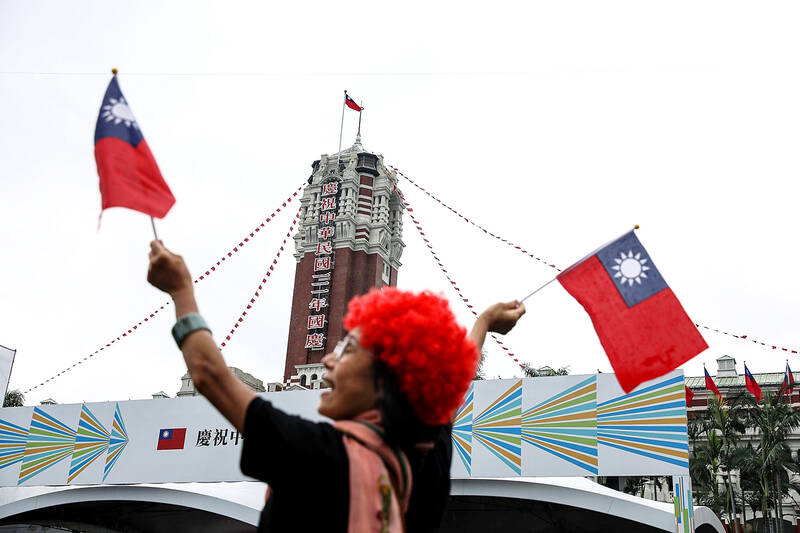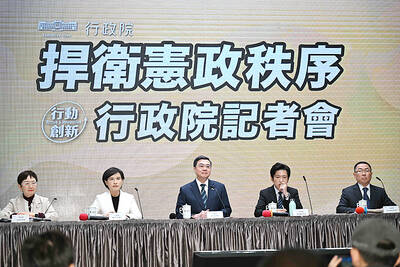Taiwan is likely to post the highest GDP per capita in East Asia, beating South Korea and Japan this year, South Korean monthly magazine BusinessKorea said in a report yesterday, citing the latest IMF estimate.
Taiwan’s GDP per capita is expected to increase to US$35,510 this year from US$33,140 last year, the report said.
That would put the nation’s GDP per capita above South Korea’s expected US$33,590 for the first time since 2003 and above Japan’s US$34,360 for the first time ever, it said.

Photo: I-Hwa Cheng, Bloomberg
South Korea’s GDP per capita is estimated to fall 4 percent this year, while that of Japan is to drop 12.6 percent from last year, the report said.
The report attributed Taiwan’s rapid GDP growth to the government’s intensive support of the local semiconductor industry.
It said Taiwan Semiconductor Manufacturing Co’s (TSMC, 台積電) sales in the third quarter were estimated to have exceeded Samsung Electronics Co’s for the first time, citing industry sources.
TSMC, the world’s largest contract chipmaker, on Friday reported a record quarterly revenue of NT$613.14 billion (US$19.23 billion) for the third quarter, up 14.79 percent from the previous quarter and an increase of 47.85 percent from a year earlier.
Market researcher IC Insights last month estimated that Samsung’s third-quarter revenue would have dropped by 19 percent to US$18.29 billion due to a slump in the memorychip industry.

The US government has signed defense cooperation agreements with Japan and the Philippines to boost the deterrence capabilities of countries in the first island chain, a report by the National Security Bureau (NSB) showed. The main countries on the first island chain include the two nations and Taiwan. The bureau is to present the report at a meeting of the legislature’s Foreign Affairs and National Defense Committee tomorrow. The US military has deployed Typhon missile systems to Japan’s Yamaguchi Prefecture and Zambales province in the Philippines during their joint military exercises. It has also installed NMESIS anti-ship systems in Japan’s Okinawa

‘WIN-WIN’: The Philippines, and central and eastern European countries are important potential drone cooperation partners, Minister of Foreign Affairs Lin Chia-lung said Minister of Foreign Affairs Lin Chia-lung (林佳龍) in an interview published yesterday confirmed that there are joint ventures between Taiwan and Poland in the drone industry. Lin made the remark in an exclusive interview with the Chinese-language Liberty Times (the Taipei Times’ sister paper). The government-backed Taiwan Excellence Drone International Business Opportunities Alliance and the Polish Chamber of Unmanned Systems on Wednesday last week signed a memorandum of understanding in Poland to develop a “non-China” supply chain for drones and work together on key technologies. Asked if Taiwan prioritized Poland among central and eastern European countries in drone collaboration, Lin

Renewed border fighting between Thailand and Cambodia showed no signs of abating yesterday, leaving hundreds of thousands of displaced people in both countries living in strained conditions as more flooded into temporary shelters. Reporters on the Thai side of the border heard sounds of outgoing, indirect fire yesterday. About 400,000 people have been evacuated from affected areas in Thailand and about 700 schools closed while fighting was ongoing in four border provinces, said Thai Rear Admiral Surasant Kongsiri, a spokesman for the military. Cambodia evacuated more than 127,000 villagers and closed hundreds of schools, the Thai Ministry of Defense said. Thailand’s military announced that

NO CONFIDENCE MOTION? The premier said that being toppled by the legislature for defending the Constitution would be a democratic badge of honor for him Premier Cho Jung-tai (卓榮泰) yesterday announced that the Cabinet would not countersign the amendments to the local revenue-sharing law passed by the Legislative Yuan last month. Cho said the decision not to countersign the amendments to the Act Governing the Allocation of Government Revenues and Expenditures (財政收支劃分法) was made in accordance with the Constitution. “The decision aims to safeguard our Constitution,” he said. The Constitution stipulates the president shall, in accordance with law, promulgate laws and issue mandates with the countersignature of the head of the Executive Yuan, or with the countersignatures of both the head of the Executive Yuan and ministers or